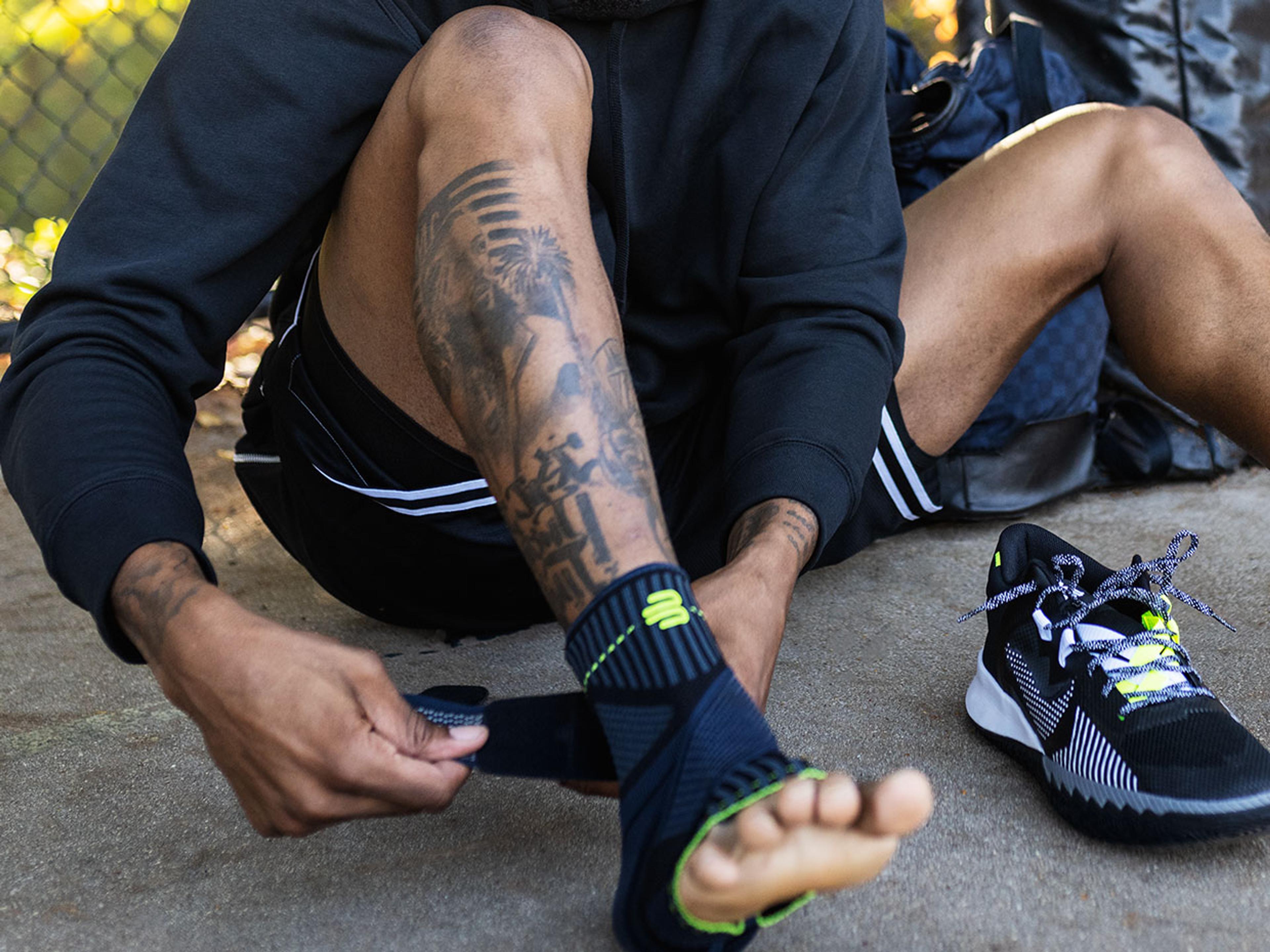Ankle sprain braces: when to use them and which ones are best
When you have an ankle sprain it’s only natural to try and find the quickest way to heal your injury so you can get back to the things you love. Ankle braces are often recommended by sports doctors and rehab professionals, but do you know why and how they really work? Or if they will help you?
This article explains how different ankle braces and supports can be used as a tool to speed up your recovery, and helps you decide which type is right for you.
Why a brace can help your ankle sprain
To heal, you need to move
The research shows that early movement is better than complete rest or immobilization. Movement brings fresh blood to the area, feeds your joints, and stimulates your body to rebuild and repair injured tissues. And these effects can speed up your recovery and reduce your risk of re-injury.
So, it’s usually best to start moving your ankle as soon as possible after you sprain your ankle. But it also means you need to protect it while you’re healing. So you can prevent your injury from worsening or re-injuring it before it’s fully healed.
So, how do you strike the right balance between doing too much and too little movement? Between protecting your ankle and encouraging it to heal?
Protected movement is key
The key to striking this balance is protected movement. This means moving your ankle within safe ranges of motion that don’t strain your injured ligaments or the other injured tissues. And keep avoiding the ones that do. An ankle brace can be a brilliant tool to help you achieve this goal.
How ankle sprain braces work
Studies suggest you’re at a higher risk of re-spraining your ankle within the first year following your injury. But, there are things you can do to minimize this risk.
First, moving and doing gentle exercises early on after an ankle sprain and incorporating proprioception (position sense) exercises into your rehabilitation program can reduce re-injury risk by 40%.
In addition to early movement and position sense retraining, using a brace during your recovery (for around 4-6 weeks) has been shown to shorten recovery times and prevent re-injury risk by 50-70%.
Ankle braces and supports work in two main ways:
By compressing the area and supporting the ankle, they may help to:
- Reduce swelling and pain
- Increase ankle proprioception (joint position sense)
Proprioception is your body’s ability to sense where it is in space. It’s controlled by sensors in your joints, muscles, and ligaments.
When you sprain your ankle, these proprioceptors are often injured and need time to heal. But, this process can take months. Wearing ankle supports while you recover can enhance your proprioception.
It does this by adding slight compression to the skin around your ankle, which has tiny sensors in it. When these sensors are compressed, they send more signals to your brain about what is happening at your ankle. Which helps your brain connect, sense, and control your ankle movement better.
Restricting ankle range of motion
Ankle braces restrict your ankle’s range of motion. Which prevents it from moving into positions where it’s vulnerable to re-injury.
The most common ligaments that are injured in an ankle sprain are on the outer side of your ankle. They become injured when your foot is turned inward (inverted) excessively and are overstretched.
An ankle brace allows your foot to move up and down into dorsiflexion (toes pointing up) and plantarflexion (toes pointing down). But stops it from turning inward or outward. This allows you to walk and run without straining your injured ligaments.
The best type of ankle brace or support to use for ankle sprains
There are many different types of ankle braces and supports available. The kind you use will depend on:
1. The severity of your ankle sprain
The more severe your injury, the more support you’ll likely need from an ankle brace or support.
2. Your rehabilitation goals in each phase of your recovery
In the early stages of your injury recovery, you may need a brace that limits your ankle range of motion and provides firm compression. But, as your rehab progresses and you heal, you may need a brace that allows more ankle movement with less compression.
If you would like to learn more about what exercises are best for your recovery, our ankle sprain exercises article has all the information you need to get started. Or use the ankle sprain rehab plan in the Exakt Health app.
3. The activities you want to do while you're recovering (and after)
Your ankle brace should allow you to keep doing the sports and activities you need and want to do while recovering from your injury. And, it should give you the right level of support for those activities.
For example, when you want to return to running. In that case, your brace must provide enough support for the high-impact nature of running without restricting your range of motion too much. Conversely, when you are getting back to football, your brace should give you enough support and stability to safely stop, turn, and change direction.
It’s important to understand that the type of brace you use will likely change throughout your rehabilitation. For example, you might need to start with a brace that firmly compresses your ankle and limits your range of motion. But, as your injury heals and you enter the later stages of rehabilitation, you might need to switch to one that offers less compression and allows more range of motion.
4. No universal "best" ankle support
There is no one-size-fits-all solution for choosing ankle sprain braces and supports. Instead, it’s about what’s best for protecting your ankle. Which depends on your individual injury, goals, and needs.
Types of ankle sprain braces and supports
Ankle braces and supports come in different shapes and sizes. They are made from various materials like elasticated fabric, neoprene, plastic, metal, or a combination.
There are two main types of ankle supports or braces typically used for ankle sprains:
Soft ankle supports for ankle sprain
Although soft ankle supports are easy to put on, lightweight, and comfortable to wear, they do not offer any protection for your ankle ligaments.
They can gently support and compress your ankle and may help reduce swelling and pain after a mild ankle sprain. If you have a more severe sprain, you can also use them, but usually only in combination or alternating with a brace.
The different types of soft ankle sprain support include:
- Compression bandages: Stretchy bandages that you wrap around your ankle (usually in a figure-of-eight pattern)
- Tubular bandage (Tubi-grip): A stretchy tubular bandage that slides over your foot and ankle and comes in various sizes to fit different calf and ankle circumferences.
- Ankle sleeves: Similar in fitting to Tubi-grip but made from different materials like neoprene, elastane, or nylon.
- Ankle wraps: Long strips of fabric that you wrap around your ankle, secured with Velcro.
Semi-rigid braces for ankle sprain
Semi-rigid braces are made from harder-wearing materials like plastic and metal. They have stabilizers (often removable) on either side and are covered by mesh or waterproof fabric. In addition, they can be fastened with laces, straps, or both.
Braces are generally bulkier than soft supports and can sometimes be awkward to put on if you have a limited range of motion in your ankle. But, they offer a high level of support, making them ideal for:
- Moderate to severe ankle sprains
- Ankle instability or recurrent ankle sprains
- When athletes need extra support during high-impact activities or return to sports training
Types of semi-rigid braces used for ankle sprain are:
- Strap-up braces
- Lace-up braces (this one is great for wearing during sport because it is not as bulky)
- A lace-and-strap combination ankle brace (offers all-round ankle protection)
Which type is better for ankle sprains? Soft ankle supports or semi-rigid ankle braces
According to most research and our own clinical experience, semi-rigid braces work better for ankle sprains. This is due to the extra support they provide your ankle ligaments and joints. Unfortunately, soft supports do not offer enough support to keep your ligaments safe from further injury while you heal.
Taping ankle sprains
Athletes often use taping to help support an injured ankle. But, there’s conflicting and limited evidence about whether it can help heal or prevent further ankle injury.
There are two main types of tape used for ankle sprains:
Rigid tape
Rigid (zinc-oxide) tape is the strongest type of tape. It provides rigid support and doesn’t stretch. It’s often used to help stabilize and protect the ankle joint during sports.
Kinesiology tape
Kinesiology tape (K-tape) is a stretchy, therapeutic tape designed to mimic your skin’s ability to stretch and move. Although the research is limited in this area, K-tape is said to help with pain relief, reduce inflammation, and promote blood circulation.
Kinesiology tape does not provide enough joint support to protect sprained ankles.
K-tape vs. rigid tape: What is best for ankle sprains?
For ankle sprains, rigid taping is considered better than K-taping. This is because rigid taping provides more support and can stabilize the joint better.
Braces or taping for a sprained ankle: Which is better?
Research suggests that ankle braces have better outcomes than rigid sports tape (non-elastic) or kinesiotape (elastic). We recommend using ankle braces for ankle sprains because:
- They are quick and easy to apply (no tutorials or assistance necessary)
- They don’t lose their level of support and are easily adjustable
- You can wear braces for extended periods without irritating your skin
- Braces are less expensive and cheaper in the long run as you’ll only need to buy one and can use it multiple times, unlike taping which cannot be reused.
Conclusion
In summary, semi-rigid braces are more effective in protecting your ankle and helping it heal after an ankle sprain than any other type of ankle support. It may also be helpful to know that soft ankle supports are better than taping when used for ankle sprains. At the same time, rigid taping is better than kinesiology tape.
However, the best way to recover from an ankle sprain is to follow a phased rehabilitation program that includes flexibility, strength, and proprioception exercises. In addition, braces can support your recovery process and protect you from re-injury.
The Exakt Health app has an ankle sprain program that includes all the exercises you need to recover from your injury. It also gives you practical tips and information to help promote your healing and manage your recovery. Like what braces to use or when taping can help.
If you are looking for a reliable program to support you recover from an ankle sprain, the Exakt Health app can help.
Good luck with your recovery!


